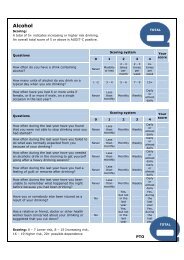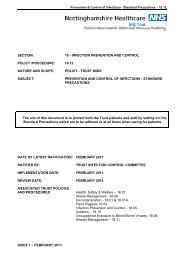Consent to Examination or Treatment Policy - Nottinghamshire ...
Consent to Examination or Treatment Policy - Nottinghamshire ...
Consent to Examination or Treatment Policy - Nottinghamshire ...
You also want an ePaper? Increase the reach of your titles
YUMPU automatically turns print PDFs into web optimized ePapers that Google loves.
<strong>Consent</strong> <strong>to</strong> <strong>Examination</strong> <strong>or</strong> <strong>Treatment</strong> – 1.03<br />
Part 4A patients who have capacity <strong>to</strong> consent <strong>to</strong> a treatment may not be given that<br />
treatment unless they consent. There are no exceptions even in an emergency. The effect<br />
is that treatment can be given without their consent only if they are recalled <strong>to</strong> hospital.<br />
Part 4A patients who lack capacity <strong>to</strong> consent <strong>to</strong> a treatment may be given it if their<br />
At<strong>to</strong>rney <strong>or</strong> Deputy <strong>or</strong> the Court of Protection consents <strong>to</strong> such treatment. They may also be<br />
given it without anyone’s consent by <strong>or</strong> under the direction of the Approved Clinician in<br />
charge of the treatment unless:<br />
• The treatment would be contrary <strong>to</strong> a valid and applicable Advance decision (if the<br />
patient is over 18).<br />
• The treatment would be against the decision of someone with auth<strong>or</strong>ity under the MCA<br />
2005 <strong>to</strong> refuse it on the patient’s behalf (if the patient is over 16).<br />
• F<strong>or</strong>ce needs <strong>to</strong> be used <strong>to</strong> administer the treatment and the patient objects <strong>to</strong> the<br />
treatment. F<strong>or</strong>ce means the actual use of physical f<strong>or</strong>ce on the patient. The question <strong>to</strong><br />
be asked is simply whether the patient objects. All relevant evidence should be taken<br />
in<strong>to</strong> account, so far as reasonably can be. If there is reason <strong>to</strong> think that a patient would<br />
object if able <strong>to</strong> do so then the patient should be taken <strong>to</strong> be objecting.<br />
• Medical treatment f<strong>or</strong> mental dis<strong>or</strong>der may not be given (by anyone in any<br />
circumstances) <strong>to</strong> SCT patients who have not been recalled <strong>to</strong> hospital unless the<br />
requirements of Part 4A are met<br />
• Part 4A requires a certificate from a SOAD f<strong>or</strong>:<br />
o <strong>Treatment</strong> which would require a certificate under section 58 if the patient were<br />
detained.<br />
• ECT and any other types of treatment <strong>to</strong> which section 58A applies.<br />
• A certificate is not required f<strong>or</strong> a section 58 type treatment during the first month<br />
following a patient’s discharge from detention on<strong>to</strong> SCT (even if the 3 month period in<br />
section 58 has already expired <strong>or</strong> expires during that first month).<br />
• When giving Part 4A certificates SOADs do not have <strong>to</strong> certify whether a patient has <strong>or</strong><br />
lacks capacity <strong>to</strong> consent not whether a patient with capacity is consenting <strong>or</strong> refusing.<br />
However they may make it a condition of their approval that particular treatments are<br />
given only in certain circumstances. F<strong>or</strong> example, they might specify that a particular<br />
treatment is <strong>to</strong> be given only with the patient’s consent.<br />
• In an emergency, treatment can be given <strong>to</strong> Part 4A patients who lack capacity (and who<br />
have not been recalled) by anyone whether <strong>or</strong> not they are acting under the direction of<br />
an Approved Clinician. It is an emergency only if treatment is immediately necessary <strong>to</strong>:<br />
• Save the patient’s life;<br />
• Prevent a serious deteri<strong>or</strong>ation of the patient’s condition and the treatment does not<br />
have unfav<strong>or</strong>able physical <strong>or</strong> psychological consequence which cannot be reversed;<br />
• Alleviate serious suffering by the patient and the treatment does not have<br />
unfav<strong>or</strong>able physical <strong>or</strong> psychological consequences which cannot be reversed and<br />
does not entail significant physical hazard;<br />
• Prevent the patient behaving violently <strong>or</strong> being a danger <strong>to</strong> themselves <strong>or</strong> others and<br />
the treatment represents the minimum interference necessary f<strong>or</strong> that purpose, does<br />
not have unfav<strong>or</strong>able physical <strong>or</strong> psychological consequences which cannot be<br />
reversed and does not entail significant physical hazard.<br />
ISSUE 6 – AUGUST 2012 23










